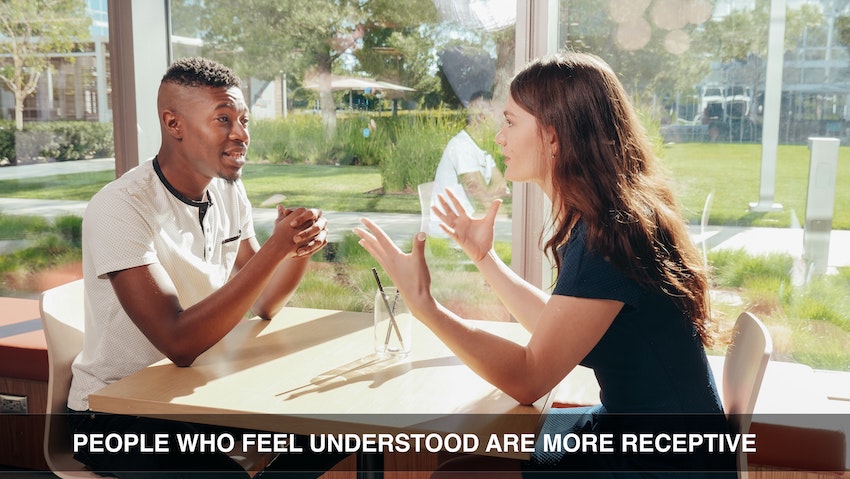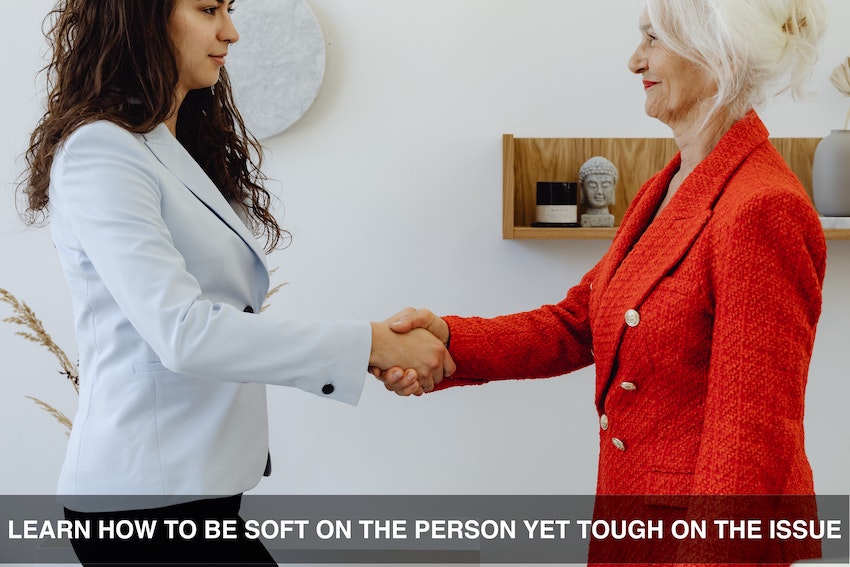Training For Dealing With Passive Aggressive Behaviour
Master Communication in Complex Dynamics
Refine your communication skills by learning to harness your emotional intelligence with one of the UK's most acclaimed management training courses.
Why Choose This Training Course?
More Than Just A Course Of Lectures
What gets in the way of developing and holding on to new communication skills are old habits of thinking and speaking. Even if the advice is very good the reason why it rarely sticks are the mental habits people inevitably revert to, especially under pressure.
Unlearning those old habits and internalising a more effective and lasting approach to communication needs more than a short course of lectures on how to do it.
What Makes This Training Stand Out?
What makes this coaching stand out is the exceptional support through one-to-one coaching sessions and continuous feedback. Changing behaviour is not an easy task as old habits are hard to break.
With a 40-year track record we can help you cultivate practical skills, and build your confidence to so you can successfully navigate real-world challenges, ensuring lasting behavioural improvements.
Testimonials
Join thousands of participants getting results
"What I love about this course is that I didn't just learn about the topic, this course is about ME. I'm confident I can reliably use my new skills, even when under pressure".
![]()
"A lesson for life! The power of effective communication is incredible when one masters the skills "listening with empathy" and "speaking assertively"
![]()
Clients We Have Worked With
Well-known companies who have used this course again and again, over many years
Course Summary
Training Objectives
We've all felt the sting of a backhanded compliment or suffered through a colleague's silent treatment. It's passive-aggressive behaviour, and it's as perplexing as it is frustrating.
This training course will guide you through spotting and smoothly handling these indirect zingers at work. You’ll learn strategies that'll bring positivity back to your team.
- Spotting passive aggressive behaviour at work is important. Look for silent treatments, eye rolls, or not doing tasks well on purpose.
- Talking directly to the person in a kind but firm way can help stop passive aggression and improve teamwork.
- Creating a safe place at work where everyone feels okay to talk openly makes it easier to solve problems together.
- Training in soft skills like talking clearly and solving problems helps people get better at handling conflicts without being mean.
- When workplaces handle passive aggression well, teams work better together, feel happier and do their jobs well.
Develop Your Emotional Intelligence
You will learn a set of powerful emotional intelligence communication techniques so that you can manage difficult conversations, handle challenging situations, build relationships and set firm boundaries.
Transferable Skills
The goal of this training is to equip you with the tools they need to build strong, lasting relationships in your professional life, although because these skills are so transferable many clients report vast improvements in their personal relationships as well.
Develop Skills
This is a skills development rather than just a theoretical programme, so the emphasis throughout will be on you taking turn after turn, practising your skills, while receiving feedback and coaching about your effect on others.
Repeated Practice and Feedback
In your coaching sessions you will be helped to practise dealing with the kinds of situation you find challenging, again and again, until you are confident you can do it successfully.
Video Analysis
We'll combine practical, hands-on experience with video replay and analysis and discussion of the principles involved to help you gain both skills and understanding. Special attention is paid to your individual training needs, so you can practise your skills in real-life situations that you have to handle at work.
Sustained Change
That's why as well as your place in a small group, this training includes a generous amount of private and confidential one-to-one coaching sessions online, spread over several months, ensuring an exceptional level of support. This will ensure the changes you make are sustained over a longer period of time and any obstacles are overcome. Choose between online training available worldwide, or in-person face-to-face courses in the UK.
Course Dates and Price
For a list of upcoming course dates (for online coaching and face-to-face training), the locations of the next 3-day public courses in the UK and pricing Click here.
Free Initial Session
This initial coaching session serves as an introduction to the "Skills with People" course, allowing you to understand the course's relevance and effectiveness for your specific needs before committing to it.

Understanding Passive Aggressive Behaviour
Passive aggressive behaviour is’t just those hushed murmurs or eye rolls in meetings - it’s a pervasive issue with real clout over work vibes and outcomes.
It's like an emotional flu that spreads unchecked, infecting colleague camaraderie and employee zest for their roles.
Definition
Passive aggressive behaviour means not saying what someone really feels or wants. Instead, the person might stay silent, give someone the cold shoulder, or do things in a sneaky way to show they are upset.
It's like sending a message without using words and often confuses others. This kind of action can make people feel uncertain because it hides the true feelings behind indirect actions.
For example, someone who is passive aggressive might agree to help with a project but then take a long time to do their part. They may give backhanded compliments that sound nice at first but actually hurt.
These are ways of showing unhappiness without speaking openly about it.
Impact on workplace and business results
Passive aggressive behaviour can make a workplace feel unsure and full of mistrust. A co-worker might agree to do a task but then does it slowly or badly on purpose. This hurts the team because work gets delayed or messed up.
It can also make people not trust each other, as no one is sure who will do their job right.
This kind of behaviour affects the success of a business too. When passive aggression becomes normal, it leads to deep-set resistance across the company; projects stall and teams struggle to stay positive.
People start feeling stressed and unhappy, which means they may not work as well or come up with good ideas. This makes everything harder for everyone and can stop a business from doing its best.
Effect on colleague and employee wellbeing
Moving from the broader workplace impact, it's clear that passive-aggressive behaviour hits close to home when we look at our colleagues and employees. This kind of behaviour can hurt feelings and make work hard for others.
When someone acts in a passive-aggressive way, it might confuse their teammates or leave them feeling unsure about how to react. This creates stress and can make people not enjoy their jobs.
Team members may become less happy and trust each other less because of passive aggression. They might find it hard to talk openly or share ideas if they worry about hidden anger or unexpected reactions from others.
Good relationships at work are important - they help us feel safe and supported. But if there's passive aggression, these bonds can break down, leading to a place where no one feels good coming into work each day.

Identifying Passive Aggressive Behaviour in the Workplace
Identifying Passive Aggressive Behaviour in the Workplace:
Spotting the silent eye rolls and unheard sighs? If so, you might be witnessing passive aggressive behaviour – a silent saboteur of office morale. It's that unspoken tension—you feel it thick in the air—masking resentment behind polite smiles or "urgent" forgetfulness when deadlines approach.
Signs to look out for
Sometimes, it's hard to spot passive aggressive behaviour. People might not even know they're doing it. Here are signs that someone may be acting this way:
- Hidden anger: They might say things are fine, but their actions show they're upset.
- Hinting, not saying: Instead of telling you what's wrong, they drop small clues and hope you'll guess.
- Sudden sarcasm: Jokes can hide real feelings of anger or annoyance.
- Being late on purpose: They might delay tasks or miss deadlines as a way to get back at others.
- Not doing what they say: Watch for people who agree to do something but then don't follow through.
- Blaming everyone else: These folks often point fingers at others for their own mistakes.
- Small acts of rebellion: Look out for tiny ways they try to fight against rules without being obvious.
Recognising the root cause
After spotting the signs of passive aggressive behaviour, it's key to dig deeper. Often such actions stem from hidden pain like childhood hurts or feeling small inside. People might act out in sneaky ways because they don't know how to talk about what’s bothering them.
Or perhaps they fear being honest will start a fight. To fix the problem, we need to see where it started.
Understanding why someone acts this way is hard but important. Some folks struggle with feelings of anger or sadness and don't even know it themselves. They might need help, like therapy, to work through these tough emotions that lead them to behave badly at work.

The Consequences of Allowing Passive Aggression in the Workplace
The Consequences of Allowing Passive Aggression in the Workplace
Turning a blind eye to passive aggression can seep into the very fabric of your office culture, subtly eroding the pillars of teamwork and trust. This toxic behaviour goes beyond awkward daily encounters; it saps energy, stifles innovation and might just be the silent saboteur of business success.
Decreased morale and productivity
Low morale spreads like a cold in the office. Workers feel less happy, and they don't do their best work. They might start to miss deadlines or make more mistakes. This can slow down the entire team and lead to even bigger problems.
Feeling stressed and upset is common when dealing with passive aggressive people at work. These feelings make it hard for everyone to focus and move forward together. The team's energy drops, and so does the quality of their work.
It's like trying to run in deep water – extra hard with little progress!
Negative effects on team dynamics
Passive aggressive behaviour is like a slow poison in teams. It might start small, but over time it creates distrust and tension among team members. People stop sharing ideas freely because they fear the silent treatment or indirect criticism from passive aggressive co-workers.
Suddenly, you've got a team where no one wants to speak up or take risks.
This toxic behaviour can make even simple tasks feel hard. Teammates may end up working alone to steer clear of drama, which kills the spirit of collaboration. A once energetic team turns quiet and disconnected, all because passive aggressiveness wasn't stopped in its tracks.
Impact on company culture
Passive aggressive behaviour hurts how a company feels inside. It can spread from one team to another, making everyone feel uneasy and unhappy. People start acting like the problem person, not saying what they really think or feel.
They may ignore problems, avoid talking about mistakes, or give each other the silent treatment.
This bad feeling changes the way the company works. Trust goes down and teams do not work well together anymore. Work gets harder for everyone and it's tough to get things done as a group.
The office turns into a place where no one wants to be because of all this negative energy. Everyone starts expecting sneaky behaviour instead of good teamwork and clear talks.

Techniques for Dealing with Passive Aggressive Behaviour
Mastering the art of defusing tension—when you're faced with the silent treatment or under-the-table jabs, we'll guide you through tried-and-tested strategies to tackle passive aggression head-on, so keep reading for a more harmonious workplace.
Addressing the behaviour directly
Talk to the person showing passive aggressive behaviour right away. Make it clear what actions are not okay and ask them why they act this way. Stay calm and use a kind voice, but be firm about what needs to change.
This makes hiding behind such behaviour harder for them.
Set rules that everyone understands. When someone acts passive aggressively, point it out each time. Ask questions that are straight to the point, like "I noticed you rolled your eyes when I suggested an idea–is there something you want to say?" This helps stop people from using indirect ways to share how they feel and pushes them towards better communication.
Creating a safe and open environment
After tackling passive aggressive behaviour head-on, it's crucial to build a place where everyone feels safe and heard. Managers play a key part here, setting up an atmosphere that encourages open chats and trust-building.
This means people can share their ideas or worries without fear of being judged or ignored. Creating such an environment helps spot problems early and stops negative feelings from building up.
It also makes sure that team members don't hold back valuable input that could help the whole group do better.
A big step towards this goal is promoting two-way communication. Everyone should feel they can talk and be listened to. This kind of setup boosts teamwork and helps solve issues together.
By doing so, managers show they care about what's behind actions like giving someone the silent treatment or other signs of acting passive aggressively. They also make clear that expressing negative emotions in healthy ways is okay, which is much better for everyone's mental health.
Effective communication
Creating a safe and open environment sets the stage for clear talk. To handle someone who acts passive aggressive, you must speak well. This means being honest but kind when you chat with them.
Tell them what you see and how it affects the team. But be ready to listen too! You might find out why they act this way.
Use easy words and stay calm when you talk about hard things. Ask questions that help them share their feelings without feeling attacked. Keep eye contact to show you care and want to understand.
Clear talks can break down walls of silent treatment or mixed messages from a person acting passive aggressive.

The Role of Soft Skills Training in Combatting Passive Aggression
Looking at soft skills development, we unlock the toolbox needed to dismantle passive aggression at its core - think of it as equipping your people with the social savvy to navigate and defuse tension.
It's about honing those interpersonal finesse that can turn a potentially toxic office dance into a harmonious waltz.
How soft skills can improve conflict resolution
Soft skills turn tough talks into teamwork. They help us understand what others feel and need. When there’s a fight, these skills keep the peace. With soft skills, you can listen well, talk clearly, and solve problems together.
People learn to be upfront without being mean or making others mad.
Learning soft skills is like getting tools for fixing conflicts. It's about knowing how to act when someone is not talking straight or showing silent anger. Training gives everyone a fair chance to share thoughts without fear of fights or hard feelings.
This makes work nicer for all and gets jobs done better.
Strengthening problem-solving abilities
Problem-solving is like a muscle that gets stronger with practice. Soft skills training can turn tricky situations into chances to grow. People learn how to tackle tough talks and sort out disagreements.
This makes for a happier place to work where people fix problems, not hide from them.
This kind of learning also helps folks see things in new ways – they don't just guess what's wrong, they ask and listen. They look for solutions together, which beats letting troubles brew.
And as everyone gets better at fixing issues, the whole team starts to shine brighter.
Next up is enhancing communication skills..
Enhancing communication skills
Talking better can make a big difference. It helps stop stress and bad vibes from passive-aggressive actions at work. People need to say what they mean in a strong but kind way. This stops misunderstandings and shows respect.
Also, it's good for sorting out troubles before things get worse.
Learning how to chat without making others feel attacked is key too. It means everyone can share ideas and feelings honestly. And that's great for working together well as a team. Next up, let’s look into steps we can take when someone acts passive-aggressively.

Steps for Addressing Passive Aggressive Behaviour
Confronting passive aggression head-on can be tricky; yet, it's crucial for a harmonious workplace. Learn how to skilfully navigate these waters with practical strategies that shine light on underlying issues—minus the confrontation—guiding towards positive change and accountability.
Identifying and flagging up the behaviour
Spotting passive-aggressive behaviour is key. Look for signs like a co-worker giving someone the silent treatment or spreading rumours. Often, these actions show hidden anger or frustration without open conflict.
Make people aware when you see these things happen. It might be tough, but it's important to call out the passive-aggressive ways.
Talk about what you notice with the person doing it. Say what you saw and how it affects others. Ask them why they acted that way to understand their reasons better. This can help stop such actions from hurting morale and teamwork in the workplace.
Discussing the situation with the individual
Talking to someone who might be acting passive aggressive can be tricky. Make sure you're calm and ready for a chat. Explain what actions or words felt passive aggressive to you. But use "I" statements, so the person doesn't feel blamed.
For example, say "I felt confused when I didn't get a clear answer." That way, they're more likely to listen and not get defensive.
It's important that they know where you stand. You should also find out why they acted that way. They might not even realise they were being passive aggressive! By chatting openly, both sides can understand each other better and work on fixing things together.
Remember, it’s key to keep these talks respectful and honest - this helps everyone involved!
Understanding the root cause
After discussing the issue with the individual, it's time to dive deeper. Knowing why someone acts in a passive aggressive way helps sort things out. People don't just wake up and decide to be difficult.
Often, there's anger bubbling under the surface they can't show outright. Or they might feel scared or not sure how to talk about what bothers them.
Some might have mental health issues driving their actions. It could be stress at home or past experiences that taught them this indirect way of showing they are upset is safer than being open about it.
By looking into these deeper reasons, we get closer to fixing the problem and helping everyone work better together.
Holding individuals accountable
It's vital to hold people responsible for passive aggressive actions. This means talking about their behaviour and making it clear that it's not okay. It might feel tough, but it shows you're serious about a positive workplace.
The goal is to help them see how their actions affect others and guide them toward change.
A plan for improvement can turn things around. Work with the person to set goals and ways to track progress. Praise steps forward, but also be ready to take stronger action if needed.
Change won't happen overnight, but with patience and firmness, the work environment can improve for everyone.
Creating a plan for improvement
Set up a plan to make things better when you see passive aggressive actions. First, spot the trouble behaviour and call it out. Keep cool, use jokes lightly if they help. Talk clear and strong when you face the person showing this behaviour.
Ask questions to learn why they act this way. Could be something deeper making them unhappy or mad.
Make rules that everyone knows about how to work well with others. Say what will happen when these rules break down, but also show how to fix problems with good talking and kindness.
Check on how people are doing often and give support for getting better at dealing with hard feelings in smart ways.
Now, it's time to talk about the benefits of beating passive aggressive acts.

Benefits of Overcoming Passive Aggressive Behaviour
Mastering the art of effectively tackling passive aggression transforms not only your daily interactions but reshapes office vibes altogether. Imagine a workplace where clear, honest communication is the norm and where teamwork thrives—a place not merely productive, but positively buzzing with potential.
Improved workplace morale and productivity
Happy teams work better. When people feel good at work, they do more and make fewer mistakes. They help each other and share ideas to get the job done well. People stop being silent or making things hard for others when everyone talks openly about problems.
The whole office starts to buzz with energy. Teams can solve tough tasks quickly because no one is hiding their feelings or avoiding talking.
Everyone wants to do well in a place where they are heard and respected, leading to great results for the business. This makes the company stronger and everyone enjoys coming to work every day.
With passive-aggressive behaviour out of the way, it's time to look at how strong team bonds form..
Better team dynamics
As productivity rises, so does the quality of how a team works together. Good dynamics mean people get along and understand each other better. Everyone feels safe to share ideas and speak up without getting shut down by someone acting in passive aggressive ways.
Let's say someone used to stay quiet or make snide remarks; now they join discussions with helpful input.
In a healthy team, folks trust one another more. They know their teammates won't ignore them or secretly be angry when there's a problem. Instead of leaving nasty notes or giving each other the silent treatment, coworkers talk it out like friends do when they have something on their mind.
This kind of change makes everyone happier at work and helps the whole company do better.
Positive impact on company culture
Getting rid of passive aggressive behaviour makes work a happier place. When people stop being sneaky with their anger, everyone feels better. This means they do more and better work.
Talks are clearer, teams get along well, and the whole company feels the good vibes. A happy team spreads positive energy that can touch every part of the business.
Tackling such behaviours shows that a company cares about how people feel at work. It tells everyone that bad attitudes won't win here. Workers trust each other more, share ideas freely, and aren't afraid to speak up because they know they will be heard in a fair way.
This trust builds a strong group where people want to stay and grow together.

Conclusion
Dealing with passive-aggressive behaviour isn't easy, but it's doable. It starts by spotting the signs and talking about them openly. When we handle these tricky actions head-on, our work lives get better.
We build stronger teams and a happier place to be every day. Now, let's explore resources for further learning about this topic.

Dealing With Passive Aggressive Behaviour FAQs
1. What are signs of someone being passive aggressive?
Signs include giving the silent treatment, making intentional mistakes, and not sharing critical information. These show a person is upset but avoids direct conflict.
2. Can passive aggressive actions be a part of a personality disorder?
Yes, they can. Passive aggressive behaviours might point to negativistic personality disorders, where the person often feels anger under their actions.
3. How do I deal with a co-worker who's passive aggressive?
Respond with calm and direct communication. Try to understand why they act this way but don't accept rude behaviour.
4. Why would somebody act in a passive aggressive manner?
People may use this communication style because it seems safer than showing anger openly—or they might not have strong social skills for healthy talks about problems.
5. Is therapy helpful for passive aggression?
Therapy, like interpersonal therapy or social skills training, can help by teaching better ways to talk about feelings and needs without hiding true emotions behind indirect actions.
6. What should you do if your family member shows examples of passive aggressive behaviour?
Start by gently talking about their behaviour; suggest ways to speak clearly about what bothers them—therapy could help if things get tough.
7. What are some passive aggressive behaviors, and how can one recognize passive aggressive behavior in a person with a passive aggressive personality disorder or those displaying such behavior?
A: Passive aggressive behaviors can take many forms and are often subtle, making them challenging to recognize at face value. Some passive aggressive examples include the silent treatment, using sarcasm, procrastination, or making backhanded compliments. A passive aggressive person may appear friendly on the surface but exhibit underlying anger or resentment. To recognize passive aggressive behavior, pay attention to their responses in situations where they might feel attacked or out of control. In some cases, passive aggressiveness can be a symptom of certain mental health conditions. If you suspect someone is engaging in toxic behavior or exhibiting passive aggressive behaviors, addressing the issue and starting therapy may be more effective than disciplinary action. It's important to reflect on your own behaviors and seek professional help to understand and manage passive aggressive behavior in yourself or others.






















